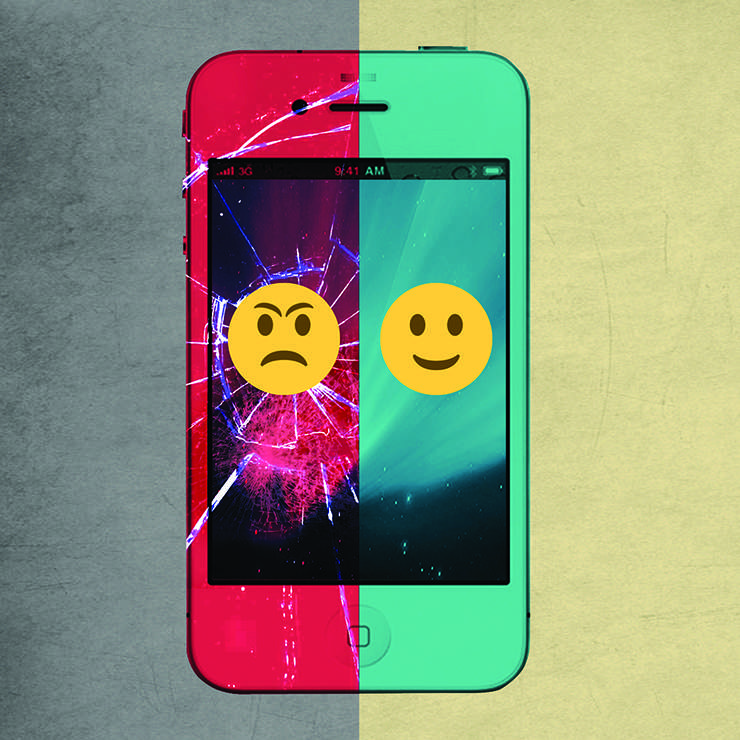Once upon a time, technology served to increase human efficiency and accuracy. Now, between everything we have to attend to on our devices and the countless ways they grab attention, it sometimes feels like our lives aren’t enhanced as much as unsettled by personal devices. When we let technology run rampant, our mental and physical health may suffer.
The Tech Effect
It starts with child development. Studies show that under-monitored screen time potentially disrupts attention, behavior, language, and academics. For teens and adults, smartphones ping and buzz all day and night. Research suggests that being reachable 24/7 escalates stress, interrupts social interaction, and impacts productivity. One study showed the mere presence of phones visible on the table disrupts conversation.
Social media, for all its potential benefits, has been linked to decreased well-being, increased depression, and escalated jealousy. The ongoing study Monitoring the Future of Teens showed that teens spending more time on screens are more likely to be unhappy than those spending less. Even Facebook and Apple have conceded social media affects at least some people for the worse.
When it comes to physical health, studies show teenagers today have become as sedentary as the average 60-year-old. Increased screen time has been linked to obesity, using a device (or television) near bedtime to poor sleep. One study correlated increased screen hours with odds of dying young. Strange as that seems, it’s possible that upping your screen time impacts other lifestyle factors, like healthy diet and exercise, that contribute to a long and healthy life.
It’s Workable
These effects are not directly caused by our gadgets, of course. They reflect how we live, starting with the expectation of constant connection. It’s also our often-unconscious choices about which activities screens replace, their potential to distract from productivity and face-to-face communication, the emotional influence of social media, and more.
It’s important to stay connected through work or socially, but instead of “batching” time online, we interrupt ourselves repeatedly all day. That undermines efficiency and disrupts our down time. And, unlike with previous innovations (such as, say, the wheel), screen usage is manipulated by products and games designed to hook us.
Mindfulness helps us choose how we live with technology. We can elect to remain available for what’s urgent, connect with friends, entertain ourselves…and also value disconnecting for a bit.
Mindfulness helps us choose how we live with technology. We can elect to remain available for what’s urgent, connect with friends, entertain ourselves…and also value disconnecting for a bit.
Take Stock
Try using a daily calendar and fill in everything you value: time for sleep, work, or school, homework, reading for pleasure, exercise, being outdoors, after-school activities or hobbies, friends, and quiet time. Whatever time is left is the maximum available for a screen.
Another trick is to ask yourself: What percentage of my down time goes to a screen? While technology seems like the ideal fill-in for daydreaming and boredom, often it is in these idle moments that creativity arises. Apps like “Moment” and “Quality Time” allow us to self-monitor time online.
Set Boundaries
When you’re with other people, including at mealtimes, put away your device. Avoid “phubbing”— dissing strangers by making no eye contact while on your phone. Set personal and family guidelines for situations that are appropriate for texting, games, and watching TV.
Avoid temptation by turning off any unneeded notifications on your devices. When the phone rings or vibrates, practice taking a breath before deciding if it needs immediate attention or if it can wait.
Mindfulness involves being aware of our habits. Catch yourself often, notice how you’re living— and what’s driving your on-screen experience— and then engage in active decision-making.
Intentional Phone Practice
How can we use our phones with more intention? We can start to notice when we’re checking them compulsively, out of FOMO (fear of missing out), or comparing our life to social media’s polished but unreal images. Try this mindful tech practice to make your phone a healthier part of everyday life.
- Before touching your phone, catch yourself. Each time it rings, pings, or vibrates, first gather your attention. Is it time to check it right now or could it wait? Take a few breaths, focusing on the air moving near your nose and mouth. Then decide what to do next.
- If you start mindlessly plugging in, catch yourself. How does your body feel, and your facial expression and posture? (A hunched thumb-typing stance may adversely affect your mood.) What do you notice emotionally, and how is it influenced by whatever you’re looking at? Where are your thoughts? Past or future? Comparing and consuming, or engaged and balanced?
- After time on your phone, catch yourself once more. Take a breath or two. Note whatever is going on and who is around you. In this moment, you can reconnect to real life, in real time.
This article appeared in the April 2018 issue of Mindful magazine.
The post Tech Yourself, Don’t Wreck Yourself appeared first on Mindful.
from RSSMix.com Mix ID 8196908 https://www.mindful.org/tech-yourself-dont-wreck-yourself/


No comments:
Post a Comment